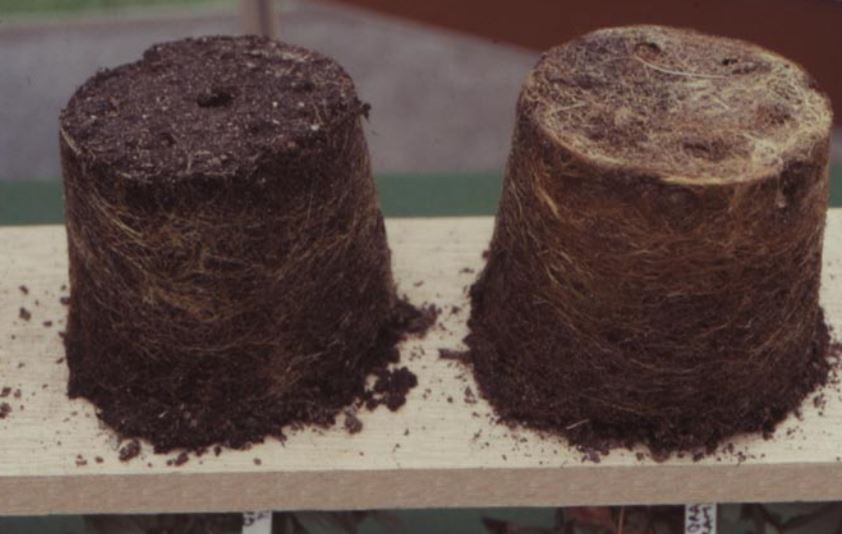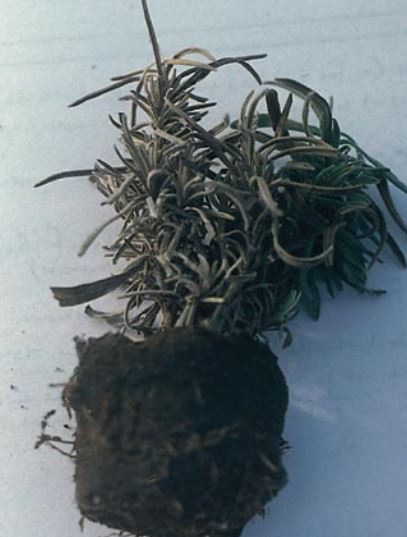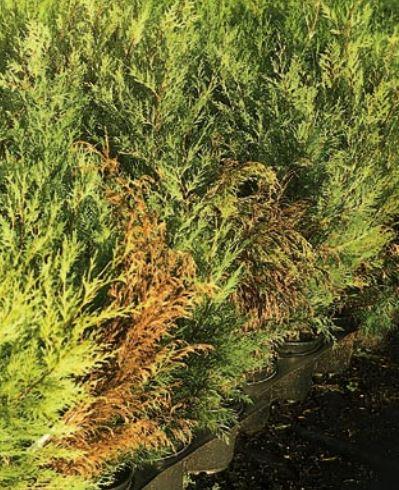Please click here to access the main AHDB website and other sectors.
- Home
- Knowledge library
- Causes of winter-injury in container grown nursery stock
Causes of winter-injury in container grown nursery stock
Waterlogging happens even in the mildest winters, wind frosts can be very damaging to foliage, while leaves, roots and stems are all susceptible to freezing injury. Read more about the causes of winter-injury.
This information was last updated in 2005.
Back to the main page: winter protection of container grown nursery stock
Waterlogging
This is the most common type of damage and occurs even during mild winters (see figure 1).
It usually associated with poorly structured growing media and inadequate drainage of container beds.
The availability of oxygen to the roots diminishes where an excess of free water occurs, leading in some situations, to extensive root death.
Disease infection may follow as wet conditions encourage the development of soil/water borne pathogens such as Pythium and Phytophthora, the latter of which can be especially damaging even to established container stock.
Slower growth
Not only are waterlogged container plants less able to survive cold winter periods but they are also slower to resume growth the following season.
Where extensive root loss has occurred, plants are often unable to recover and fail to grow in spring, leading to high levels of wastage.
Nursery stock subjects particularly susceptible to water logging include Caryopteris, Cistus, Choisya, Convolvulus cneorum, Hebe, Ilex, Olearia, Rosmarinus and Senecio.
Many conifers are also susceptible, particularly cultivars of Chamaecyparis lawsoniana, Juniperus and Taxus.
Sustained spells of low temperatures coupled with waterlogged roots are particularly damaging combination likely to cause serious losses.
 RSK ADAS
RSK ADAS
Figure 1. Waterlogging damages root systems and is the most common cause of winter injury. Growing media and container bed must be well drained and irrigation carefull managed.
Freezing injury
Freezing injury to leaves and stems occurs when ice crystals form within the cells of the plant causing the cells to rupture.
Root systems can be similarly damaged; being situated above the ground in containers, they are exposed to much lower air temperatures than when grown in the open ground, where root systems are typically more extensive and robust. Injury to root systems is usually more serious and long term.
Waterlogged containers and standing beds damage root systems and exacerbate freezing injury, so predisposing plants to further damage.
Nursery stock subjects such as Cistus , Hebe , Lavendula (see figure 2) and Senecio are particularly vulnerable and frequently require protection from freezing temperatures.
 RSK ADAS
RSK ADAS
Figure 2. Freezing injury exacerbated by waterlogged containers and beds - species such as Lavendula are particularly vulnerable.
Wind chill damage
Strong winds combined with low, freezing temperatures also cause plant damage, sometimes referred to as ‘wind chill’.
Typical symptoms include extensive leaf necrosis, browning and a ‘scorched’ appearance to the foliage of the plant (see figure 3).
Wind frosts too can be very damaging to the foliage of broad-leaved evergreen subjects and damage flower buds so reducing saleability, particularly of spring flowering varieties such as Camellia, Magnolia and Rhododendron.
Adequate shelter is essential for these subjects.
 RSK ADAS
RSK ADAS
Figure 3. Brown discolouration on conifers is a classic symtom of dessication and is exacerbated by strong, cold winds and bright sun.
Root-killing temperatures
Clearly, the hardiness of different nursery stock subjects determines their ability to tolerate and survive freezing temperatures (see table 1).
Similarly, the roots of some subjects are less able to survive sustained periods of low temperature and so are more susceptible to damage.
Damaged roots typically turn soft and quickly discolour. Disease infection may follow.
Variation
There’s considerable variation in the ‘root hardiness’ of different subjects; -5°C seems to be the key threshold for many nursery stock subjects below which root damage is likely to be more serious.
Subjects with fleshy roots such as Magnolia are particularly susceptible.
This should be considered when prioritising container stock for over-wintering under protection particularly if space is limited and when allocating bed space at potting.
Table 1. Root killing temperatures of container grown nursery stock. Source: USDA / ADAS.
 ADAS/USDA
ADAS/USDA
Drying out
Sometimes referred to as ‘physiological drought’, winter damage caused by desiccation is quite common and most frequently seen amongst upright conifers (including many hedging varieties) and broad leafed evergreen subjects such as Viburnum tinus, Mahonia, Camellia and Aucuba.
Foliage usually discolours, turns brown quite quickly and often appears scorched.
Desiccation or ‘wind scorch’ occurs when water uptake by the roots is exceeded by water loss from the leaves and stems.
It is exacerbated by strong persistent cold winds and bright winter sunshine when the root-ball is frozen, thereby limiting the plants ability to replace water lost from the top growth.
Deciduous subjects such as roses can also be affected.
Physical damage
This is the most immediately obvious and usually easily seen cause of winter injury to container grown plants.
Saleability of finished container stock is immediately affected and secondary damage from disease entry via wound tissue can establish quickly leading to further losses.
Heavy loads of snow and ice or persistent strong winds can quickly break branches.

